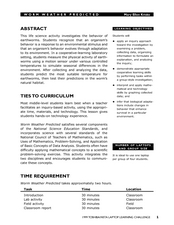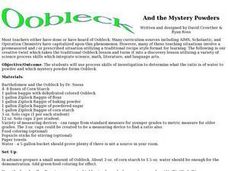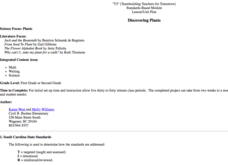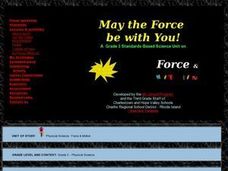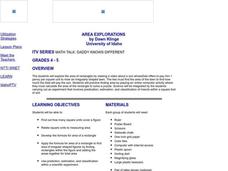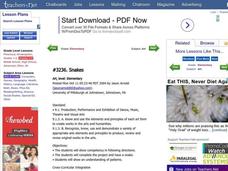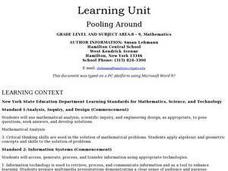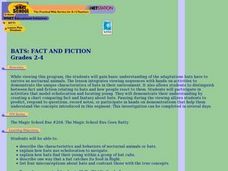Curated OER
The Oceans Below
Students investigate the geological characteristics of the ocean environment and create a labeled drawing of the ocean floor's geography. Students view videos and conduct Internet research about the ocean's floor and then create their...
Curated OER
Solving Genetic Puzzles
Seventh graders examine genetics combination using statistics. In this statistics lesson, 7th graders examine genetic trait using a table or punnett square to identify genotype and phenotype. This assignment requires more than one class...
Curated OER
From Future Flight to Past Flight
Students complete a set of CD-ROM's to introduce them to the flight program at NASA. In groups, they research a topic related to flight and put their information on a CD-ROM. To end the lesson, they share their material with other...
Curated OER
Worm Weather Predicted
Students examine worm habitats. In this animal habitats lesson plan, students participate in a lab activity that requires them to explore the adaptations that earthworms make to their environment.
Curated OER
Describing Nests
Students observe bird nests. For this observation level, students explore bird nests using their five senses. Students compare and contrast bird nests while hypothesizing about the need birds have to construct the nest.
Curated OER
Oobleck and the Mystery Powders
Students listen to the book, "Oobleck," by Dr. Suess before experimenting with mystery powders. They determine the proper ratio of powder to liquid to make the Oobleck.
Curated OER
All About Ants
Students create model ants in order to study the characteristics of insects such as body segments, number of legs, and feelers, as well as how these characteristics serve the insect.
Curated OER
Art and Anatomy: The Vitruvian Teen
Students are introduced to the history of showing the human anatomy. In groups, they measure their height and arm spans to create a graph and determine if their measurements support Vitruvius' work. Individually, they make their own...
Curated OER
My Family and Me: Our Similarities and Differences
Students are introduced to basic genetic information to discover how they acquired the traits they have. Individually, they develop a family tree and identify the similarities and differences between two poeple. In groups, they examine...
Curated OER
Rainforest Plants and Animals -- Where Are They?
Students identify the plant and animals in the rainforest. Using the internet, they research how these plants and animals adapt to survive in this type of environment. In groups, they critique artwork and discuss how they were depicted.
Curated OER
Diffusion & Osmosis with Data Analysis
Students explore principles governing diffusion and osmosis. Students perform a dialysis tubing experiment. They obtain core samples of potato in varying concentrations of sugar-water to measure water potential of the potato cells....
University of Southern California
Discovering Plants
Students construct a small greenhouse and plant lima beans. They read books about plants, tend the lima bean seedlings, observe and record plant growth, taste a variety of plants and maintain plant journals.
Curated OER
Force & Motion
Third graders are introduced to the concepts of force and motion. In groups, they travel between stations to analyze the effect of force and motion on various objects. They research how various careers use these concepts as well.
Curated OER
Is that Tree Safe?
Middle schoolers examine the parts of the tree and examine the health of trees in the vicinity. In this tree safety lesson students work in groups to complete a stated goal.
Curated OER
The Mathematical Fingerprint of Our Solar System
Young scholars study the beautiful mathematical model unique to our solar system.
Curated OER
Area Explorations
Students explore the area of rectangles. They practice finding area by playing an onliine computer activity where they calculate the area of a rectangle to solve a problem.
Curated OER
Estimation Investigation
Students view an interactive video to explore the concepts of estimation. They work cooperatively to measure, make comparisons, make predictions, and verify results.
Curated OER
Classification is Sweet
Students classify, weight and organize items during this lesson. This lesson works great as or with an introduction of the Periodic Table of Elements.
Curated OER
Snakes
Students follow directions to make a snake out of patterns. They research a specific snake and present it to the class in a group. They listen to a presentation about the King Cobra snake prepared by the teacher.
Curated OER
Pooling Around
Students complete a unit of lessons on computing area and volume. They play a Jeopardy game of basic area formulas, calculate surface area of shapes, develop a Powerpoint presentation, and conduct a simulation of finding the surface area...
Curated OER
Would You Like to Become a Millionaire?
Students answer questions written by other teams about literature in an attempt to become "millionaires." In small groups they write a motivational introduction to their teams selected books, publish their questions as a HyperCard...
Curated OER
Bats: Fact and Fiction
Learners describe the characteristics and behaviors of bats. After viewing a video, they explain how bats use echolocation to navigate and how they find their young within a group. They list four misconceptions about the animal and...
Curated OER
Snowflake Crystals
Fourth graders explore physical changes and the true life story of Wilson Bentley. They observe the changes that take place with snowflakes. Students discuss what happens when snow flakes melt. They create their own snowflakes using...
Curated OER
Fraction Equivalence
Fourth graders explore fractions. They compare different fractions using fraction bars. Students find equivalent fractions and they use fraction bars to visualize addition of fractions.



